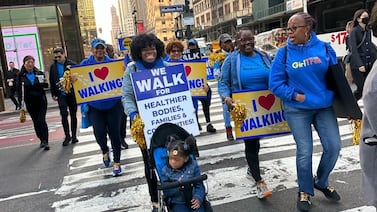Public health, explained: Sign up to receive Healthbeat’s free New York City newsletter here.
With federal investigations swirling around his administration, New York City Mayor Eric Adams pivoted on Wednesday to one of his favorite local fights: the “war on rats.”
“I don’t think there’s been a mayor in history that says how much he hates rats,” Adams said at the opening of the National Urban Rat Summit, a two-day rat mitigation conference in Manhattan. “I dislike rats.”
The embattled mayor — who has seen the resignations of his police commissioner and chief legal counsel in the past week — appeared briefly to address the researchers, experts and municipal leaders assembled in a classroom at Pier 57 to explore the challenges of rat mitigation and discuss best practices.
Rats, which can carry dangerous pathogens, have long been linked to the spread of infectious diseases. Dr. Ashwin Vasan, commissioner of the Department of Health and Mental Hygiene, told the audience that rat control is “deeply core to public health,” and presents an opportunity to advance health equity.
“The burden of rat infestation in New York City neighborhoods is not equally distributed,” he said. “That’s why we work hard to target our efforts to where they’re most needed.”
The conference lineup included sessions on the history of municipal rat management, the use of data to predict hot spots, and the impact of rats on mental health. Other sessions focused on key areas of rat mitigation, from parks and sewers to public housing and containerization.
Adams has long made eliminating rats a personal and political mission. While campaigning for mayor, he told the New York Post that as a child, he and his siblings adopted one of the rats that infested their Brownsville apartment, nicknaming him “Mickey.”
In his opening remarks on Wednesday, Adams described how traumatizing the presence of rats in homes and on streets can be for residents. Improving New Yorkers’ “health and mental stability” hinges on ridding the city of pests, he said.
“Let’s be energetic, let’s share our ideas,” Adams said. “Let’s figure out how we unify against what I consider to be public enemy number one: Mickey and his crew.”
In recent months, the Adams administration has touted its efforts to thwart rodents. A plan to containerize the city’s trash is underway, in order to eliminate what Adams described on Wednesday as the “all-you-can-eat buffets” of trash bags that have long lined the city’s streets. All businesses are now required to put their trash in containers, and starting in November, residential buildings with fewer than 10 apartments must do so as well. Containerization will expand to larger residential buildings in the spring.
The city has also focused resources on “rat mitigation zones,” areas of high rat activity, including in Harlem, the East Village, Chinatown, Bedford-Stuyvesant, Bushwick and along the Grand Concourse in the Bronx.
By some measures, the city has made progress, but work remains. The Department of Sanitation announced in May that rat sightings reported to 3-1-1 had fallen in 12 of the past 13 months compared to the prior year, and were down about 14% in the rat mitigation zones.
But rodent inspections declined in the last year, according to data released Monday in the Mayor’s Management Report, a progress report for city agencies.
The Health Department reported conducting 150,000 initial rodent inspections in the 2024 fiscal year, down from about 179,000 inspections during the prior year. Of those initial inspections, 24.2 percent of properties failed due to signs of rat activity, a similar proportion to previous years. The Health Department attributed the decline in inspections to “staffing challenges” but noted that “many vacancies have now been filled.”
Vasan described rat control as a way to liberate residents from stress, fear, and “the feeling that the place you live is in some state of disrepair or disregard.”
“Failure to manage the problem contributes to a sense of unease, at an already uneasy time,” he said. “It contributes to a sense of mistrust at an already historically mistrustful time and divided time.”
Eliza Fawcett is a reporter covering public health in New York City for Healthbeat. Contact Eliza at efawcett@healthbeat.org.







